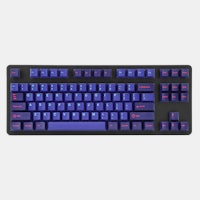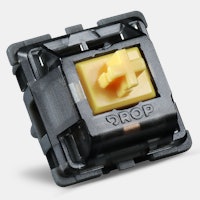Click to view our Accessibility Statement or contact us with accessibility-related questions















Mechanical vs Membrane

search
close
Sort by: Newest
keyboard_arrow_downTomElsen
0
Mar 16, 2023
I got my F97 cosmic traveller from Iqunix, in today. It is brilliant. Got already a good amount of lube on the stabilizers but I added some more Krytox. TCC's ACE switches are amazing even factory lubed.
That's what a mechanical keyboard is about. Feels and sounds awesome.
BabblingBafoon
29
Keyboard Club Member
Mar 15, 2023
Great write up! I think this should be helpful to many people.
I have over 30 custom keyboards of various brands, shapes and materials, and over 100 keycap sets (almost as many deskmats too). To say I have a "problem" is an understatement!! Also, that's not a flex, but to highlight that my "experience" covers a pretty wide range. Several soldered, mostly hotswap. Heavy (one is almost 10 pounds) to super-light. Even the newer Keychron low-profile hotswap boards (great for travel!).
I am almost exclusively tactile-gang, but some of that is my lack of finger control and the linear switches activating when I wasn't trying (I have ALS and my fingers don't work like they used to, so "resting" my fingers often led to actuation). Even when I had control, I still loved the bump. I mainly use Invyr Holy Pandas (from Drop), Gazzew Boba U4t (62g & 68g), and Glorious Pandas lubed from the factory (several others in one off implementations... but most of my boards have one of those three switches. I have disassembled and hand-lubed many switches, but I have since settled on those three brands/switches since I like them as they come and don't have to fiddle with them. It was fun lubing switches in the beginning, but it got old by the 600th switch. 😂 I still hand-lube all my stabilizers though... that's a must!
I actually have an older Microsoft membrane keyboard that had the fingerprint sensor. It stopped working, but for a membrane I actually enjoyed it! It was not mushy, had snappy feedback and decent travel for a low-profile board. On that topic, Topre switches are pretty damn nice! Problem is you can't use MX-style keycaps to make it your own, which is one of the joys of custom keyboards. However, EPOMAKER Niz series is similar to Topre, yet has MX-style stems, so you can use all the wonderful keycap sets out there! Not expensive either (comparatively)!
I got in more group buys than I care to mention. I am still waiting on some that are closing in on 2 years waiting! FOMO is a real problem for me. 😂
I don't want to over share, but happy to answer any questions if people have them!

sietai
166
Nov 12, 2022
Gotta say, one of the most under appreciated parts of the hobby is the is the ergo community creating and sharing designs that can't effectively be mass produced reasonably due to lack of interest. But even if you aren't going the weird ergo route, So many of us are typing for work all day that building a kit that feels good is well worth it.
IMO sound is the worst part about mechanicals. I've built great sounding boards that are a joy to use at home but I can't seem to build a board that feels as great to me and is quiet enough that I don't think twice about bringing it into an office setting.
Timwillhack
41
Mar 16, 2023
I didn't like anything about the Deep Sea switches. I was supposed to have gotten V2's (never verified the difference). I just ended up using them for heavier keys like ctrl etc when I was using gateron yellows, but after getting the outemu's they hold everything fine without any weird effects, so I have the silent tactile peaches as my number row and heavy keys and the rest is linear milky yellows, they have similar actuation / forces I remember correctly. I went with the Feker because of wireless and switching devices easy and after I read it supports QMK/Via(Vial). It doesn't have full support though so only one macro (that doesn't work wireless) and no tap dance or mod tap type functionality working. Only thing I could do was reprogram fn key to capslock and regular key swaps work fine. That Libra looks nice other than the case is ginormous looking !!
(Edited)

sietai
166
Mar 16, 2023
TimwillhackOoh, right. I'll have to keep that in mind. At this point qmk support is basically a requirement for me, even if it's not via compatible out the box and I have to program it myself, and I do prefer when the alice isn't WK-less. The Libra62 checks off a lot of boxes if it wasn't so massive and it's advertised as Via compatible but there's no source code and there's some features I would like to try out that can't be done in via.

Evshrug
4137
Keyboard Club Member
Nov 12, 2022
Real nice write up!!!
I have to admit… I went through a phase where I loved membrane keyboards.
When I built my first custom PC, selecting every part (and spending about $700 in 2013), I spent $12 on a Roswell keyboard 😅 I’m not saying I loved THAT keyboard… I was working in fast food, and my limited budget was going towards good “permanent” parts while I skimped out on things I thought I could upgrade to be really nice better, and that included my keyboard. Literally, painful junk 😂
Like most people, I believe, I got used to membrane keyboards when laptops became powerful enough to be your primary or only computer. And I was living in an alternate universe called “Macintosh.” Here’s where the positives were: short travel key presses, low profile caps with broad “faces” that didn’t matter if you pressed off-center, quiet, safer from small spills and easy to clean, essentially great laptop companions. Apple refined their membrane keyboards to the point where it was weird to try anything else… the Apple’s “Magic Keyboard” is still my wife’s favorite, and that is a $100 membrane keyboard!
However, the broad scope of membrane keyboard examples leave much to be desired. Many require a firmer press, all require the keycap to be pressed the full way down to bottoming out, two factors which require a more deliberate typing style lest you miss some letters. My fingers tire faster when typing more than briefly. My wife’s Compaq and Toshiba laptop keyboards from college just felt yucky! It was as if they stuck to the membrane a bit when I released pressure; if my $12 membrane board felt like tapping my finders directly on a table, these other membrane boards felt like tapping on chewing gum! The one membrane keyboard I tried that actually had a longer key travel distance was Apple’s acrylic “Pro” keyboard… they attempted to use membranes there to emulate a full-size mechanical keyboard with a full-size 100% key and number pad layout, full-size key caps, full-length keypress travel… but it has the absolute heaviest actuation force that I’ve ever experienced, has mushier and mushier feedback along the way down, and a soft rebound accompanied by a sound that is no thocc and all slapped-mashed-potatoes. Apologies to anyone that loves this unique keyboard, but for me it ranks as the absolute worst!
I’ve been enjoying a few forays into Mechanical keyboards. I have a Gateron Yellow ENTR and Halo True ENTR (https://drop.com/talk/62256/keys-to-success), plus a wireless keyboard I’ve been using to explore “silent” tactile switches. Long story short, I agree with the Hoff here, but my favorite part so far has been the springy, bouncy feel that doesn’t necessarily require a bottomed-out press. It just feels nicer with long writing tasks!
(Edited)

Evshrug
4137
Keyboard Club Member
Nov 14, 2022
The Cube was art… I was kind of giddy when Apple released the Cylinder (err, the previous Mac Pro form factor), and sad while working at Apple to see that I had to take receipts and trash out of the top air vents from our demo unit on display almost every day.
Computers, Keyboards, work spaces in general… people understand that function is important, but aesthetics are all too easy to overlook, and then they miss out on the welcoming satisfaction of sitting down to work at a “sorted out” and inspirational space.
…. which reminds me, I need to clear and organize my desk 😂

HoffmanMyster
3256
Community
Nov 14, 2022
EvshrugSo true. And speaking of organizing desks... I need to get on that too. Every time I think I've got it under control, some project forces me to litter my desk with stuff and it takes ages to clean it back up.

Nebur
0
Nov 23, 2022
"Cheap materials and the membrane design result in an incredibly mushy and terrible typing experience."
Stopped reading after that one.
PRODUCTS YOU MAY LIKE
Trending Posts in Mechanical Keyboards
theno1plug
HYOLA PRO MAX 6000 Disposable Vape
The HYOLA PRO MAX 6000 Disposable Vape https://theno1plug.co.uk/products/hyola-pro-max-6000-disposable-vape is engineered for enthusiasts who demand high-quality performance in a compact and...
Dec 3, 2024
damkei
Keyboard riser foot
Hello everyone, is there any chance I can find the risers marked in the red circles below? I really appreciate any help you can provide.
Dec 2, 2024

leadcanary5
In stock items haven't shipped yet
Hi, I ordered an MT3 (2048 extended) keycap set on Nov 25. It was supposed to be shipped on Nov 29. The keycaps have still *not* shipped. I also ordered the media keycap set (2048 extended) on Nov 26. This was shipped on Nov 27 even though the estimated ship date was Nov 29. I'm just wondering, how long it's going to take for the base keycap set to ship? Given that it had a ship date of Nov 29, and the items are actually in stock.
Nov 30, 2024

jostock
Navigating Sales & Acquisitions in Naples, Florida: A Guide to Corporate Real Estate Transactions
When it comes to corporate real estate, businesses must make informed decisions about acquiring, leasing, or selling property to ensure their success. In Naples, Florida—a prime location known for its growing economy and attractive real estate market—businesses frequently find themselves navigating complex transactions. From acquisitions to sales and the legal intricacies involved, the role of an experienced lawyer becomes indispensable. At Jostock & Jostock, P.A., we leverage our deep knowledge of real estate to guide corporate clients through these transactions. Whether it involves acquisition, development, financing, leasing, or construction of commercial real estate, we offer tailored legal services that maximize opportunities and minimize risks. In this article, we’ll explore the essential aspects of corporate real estate transactions in Naples, Florida, and explain how our firm helps clients succeed in this dynamic environment. Why Corporate Real Estate Transactions...
Nov 30, 2024
Toady01
Green Planck v7 w/ GRiD mica+resin keycaps
Green Planck V7 POM black plate GAZZEW boba U4T switches Cream (brown not shown) GRiD keycaps by @hungryhustla
Nov 29, 2024

Jonmiller21
Confused on discount
Trying to get a pair of headphones, and I saw the thing for the discount so I signed up but it says I have to check my email to get the discount, but nothing is showing up to my email. Does it take awhile or?
Nov 28, 2024
















Mechanical keyboards used to just be called ‘keyboards’. They are the original keyboard category, replaced by membrane keyboards as described above. Of course, over the years the variety of what is called a ‘mechanical keyboard’ has grown, so there are a few different types. From the old IBM buckling spring keyboards to modern Cherry MX keyboards, you’ll find all sorts of niches in between to satiate your every fantasy. We’re not going to dive into the deep end today though. Instead we’ll focus on the main reasons to go mechanical - broadly speaking. Spoiler alert: most of them revolve around customization. Benefits of mechanical keyboards
Repairability